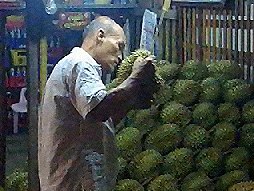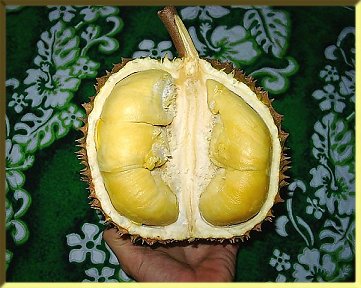 How to Select a Durian
How to Select a Durian
How can you tell if a durian is ripe?
"To choose a durian, pick a fruit which is comparatively light and whose stem appears big and solid. When shaking a good durian, the seed should move. Maturity is indicated when the middle of the fruit exudes a strong, but not sour smell. Finally, an inserted knife should come out sticky — this is the best indication that the fruit is ripe.
Cut fruit perishes fairly rapidly. Avoid fruit with holes: worms may have prior claims."
 Determining the ripeness of a durian is in Southeast Asia a fine art practiced at every marketplace countless times daily during durian season, almost a ritual.
Determining the ripeness of a durian is in Southeast Asia a fine art practiced at every marketplace countless times daily during durian season, almost a ritual.
Prospective customers examine, sniff, and shake the fruits, while sellers usually have a special padded tapping stick with which they strike each durian to demonstrate its particular "thunk" sound, almost like musicians testing some kind of natural jungle percussion instrument.
They also often will cut a triangular flap in the rind to show the consistency of the fruit flesh inside, which the prospective customer may peer into, smell, and touch with a fingertip.
Like experienced winetasters, experienced durian eaters can often accurately tell what is the variety, in what region it was grown, and what is the approximate age of the tree it came from, just by inhaling a durian’s fragrance.
The Experts
 The book Durian: Fruit Development, Postharvest Physiology, Handling and Marketing in ASEAN, edited by Sonthat Nanthachai (ASEAN Food Handling Bureau, Kuala Lumpur, Malaysia, 1994) lists 9 ways to detect the ripeness of a durian:
The book Durian: Fruit Development, Postharvest Physiology, Handling and Marketing in ASEAN, edited by Sonthat Nanthachai (ASEAN Food Handling Bureau, Kuala Lumpur, Malaysia, 1994) lists 9 ways to detect the ripeness of a durian:
- in many varieties, the tips of the spikes turn darker brown than the bases of the spikes
- the spike tips also become slightly elastic and more flexible
- the grooves between spikes expand and turn darker
- depending on variety, the fruit stem may become either more stiff or more flexible than unripe fruits
- the abscission zone in the fruit stem just above the fruit tends to bulge
- the sutures in the rind where the sections will split apart become more noticeable
- the fruit when tapped has a hollow sound—if a solid sound, it’s not ripe; when shaken, the best fruits have a sound of something moving inside, of fruit sections knocking shell
- the sap from the fruit stem will be clear and sweet; in unripe fruits, it is thick, sticky, and not sweet
- if a small "window" into the fruit is cut to check out the insides, the fragrance will be stronger and the pulp more colorful than unripe fruits
 The same book also reports: Kosiyachina (1993) classified consumers of fresh Thai durian into four groups:
The same book also reports: Kosiyachina (1993) classified consumers of fresh Thai durian into four groups:
- Those who prefer partially ripe pulp,
- Those who prefer edible ripe pulp,
- Those who prefer soft ripe pulp,
- Those who prefer overripe pulp.
That is all certainly true.
We are (not-strictly) soft-ripe durian lovers, by the way.